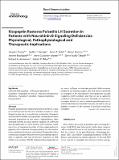Kisspeptin restores pulsatile LH secretion in patients with neurokinin B signaling deficiencies : physiological, pathophysiological and therapeutic implications
Abstract
Pulsatile gonadotropin-releasing hormone (GnRH) is crucial to normal reproductive function and abnormalities in pulse frequency give rise to reproductive dysfunction. Kisspeptin and neurokinin B (NKB), neuropeptides secreted by the same neuronal population in the ventral hypothalamus, have emerged recently as critical central regulators of GnRH and thus gonadotropin secretion. Patients with mutations resulting in loss of signaling by either of these neuroendocrine peptides fail to advance through puberty but the mechanisms mediating this remain unresolved. We report here that continuous kisspeptin infusion restores gonadotropin pulsatility in patients with loss-of-function mutations in NKB (TAC3) or its receptor (TAC3R), indicating that kisspeptin on its own is sufficient to stimulate pulsatile GnRH secretion. Moreover, our findings suggest that NKB action is proximal to kisspeptin in the reproductive neuroendocrine cascade regulating GnRH secretion, and may act as an autocrine modulator of kisspeptin secretion. The ability of continuous kisspeptin infusion to induce pulsatile gonadotropin secretion further indicates that GnRH neurons are able to set up pulsatile secretion in the absence of pulsatile exogenous kisspeptin.
Citation
Young , J , George , J , Tello , J , Francou , B , Bouligand , J , Guiochon-Mantel , A , Brailly-Tabard , S , Anderson , R & Millar , R 2013 , ' Kisspeptin restores pulsatile LH secretion in patients with neurokinin B signaling deficiencies : physiological, pathophysiological and therapeutic implications ' , Neuroendocrinology , vol. 97 , no. 2 , pp. 193-202 . https://doi.org/10.1159/000336376
Publication
Neuroendocrinology
Status
Peer reviewed
ISSN
0028-3835Type
Journal article
Collections
Items in the St Andrews Research Repository are protected by copyright, with all rights reserved, unless otherwise indicated.

